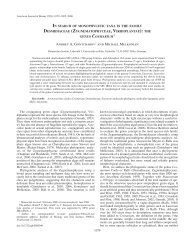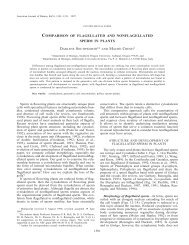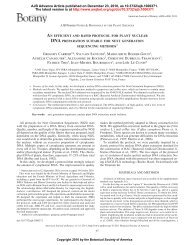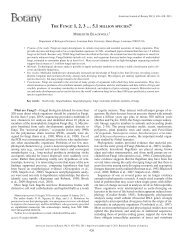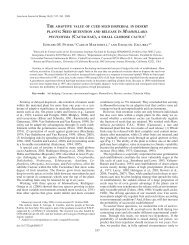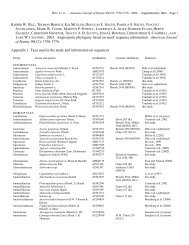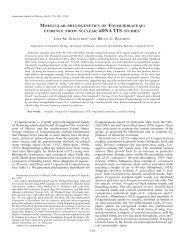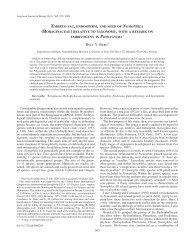View - American Journal of Botany
View - American Journal of Botany
View - American Journal of Botany
You also want an ePaper? Increase the reach of your titles
YUMPU automatically turns print PDFs into web optimized ePapers that Google loves.
September 1999] KRON ET AL.—PHYLOGENETICS OF ANDROMEDEAE<br />
1297<br />
Fig. 3. Strict consensus <strong>of</strong> 42 trees found in the parsimony analysis<br />
<strong>of</strong> rbcL data. L 503, CI 0.58, RI 0.50. Decay values are below<br />
lines, and parsimony jackknife values are above lines. Taxa traditionally<br />
placed in the tribe Andromedeae are in boldface.<br />
Fig. 4. Strict consensus <strong>of</strong> four trees found in the parsimony analysis<br />
<strong>of</strong> matK data. L 980, CI 0.65, RI 0.62. Decay values are<br />
below lines, and parsimony jacknife values are above lines. Taxa traditionally<br />
placed in the tribe Andromedeae are in boldface.<br />
Fig. 5. Strict consensus <strong>of</strong> four most parsimonious trees obtained<br />
from the combined analysis <strong>of</strong> rbcL and matK data. L 1495, CI <br />
0.62, RI 0.58. Decay values are below lines, and parsimony jacknife<br />
values are above lines. Taxa traditionally placed in the tribe Andromedeae<br />
in boldface.<br />
pendently in Diplycosia and Gaultheria. Tepuia and Diplycosia<br />
form a moderately well-supported clade (d3,<br />
71% bootstrap) supported by apical connate bracteoles<br />
(#25) and anther tubules (no. 41), as do Gaultheria and<br />
Pernettya (d4, 84% bootstrap), which may be supported<br />
by fleshy, colorful sepals. Gaultheria likely is paraphyletic,<br />
justifying the inclusion <strong>of</strong> Pernettya. The monophyly<br />
<strong>of</strong> Leucothoë is not at all supported.<br />
DISCUSSION<br />
Results <strong>of</strong> phylogenetic analyses based on morphology,<br />
rbcL, and matK sequences (Figs. 1–4) are generally<br />
similar, although analyses based on single character sets<br />
are less well resolved than the combined analyses (Figs.<br />
5–6). We note that the cladogram resulting from the analysis<br />
based on all three data sets, i.e., morphology and<br />
rbcL and matK sequences (Fig. 6), is better resolved and<br />
shows stronger statistical support for the various internal<br />
clades than any other tree produced in our analyses. This<br />
tree strongly supports the monophyly <strong>of</strong> the Lyonia group<br />
(including Lyonia, Craibiodendron, Agarista, and Pieris)<br />
and the Vaccinieae (including numerous inferior-ovaried<br />
genera), but provides only weak support for the Gaultheria<br />
group (circumscribed so as to include Andromeda and<br />
Chamaedaphne, as well as Zenobia, Leucothoë, Diplycosia,<br />
Tepuia, Gaultheria, and Pernettya). Recognition <strong>of</strong>



